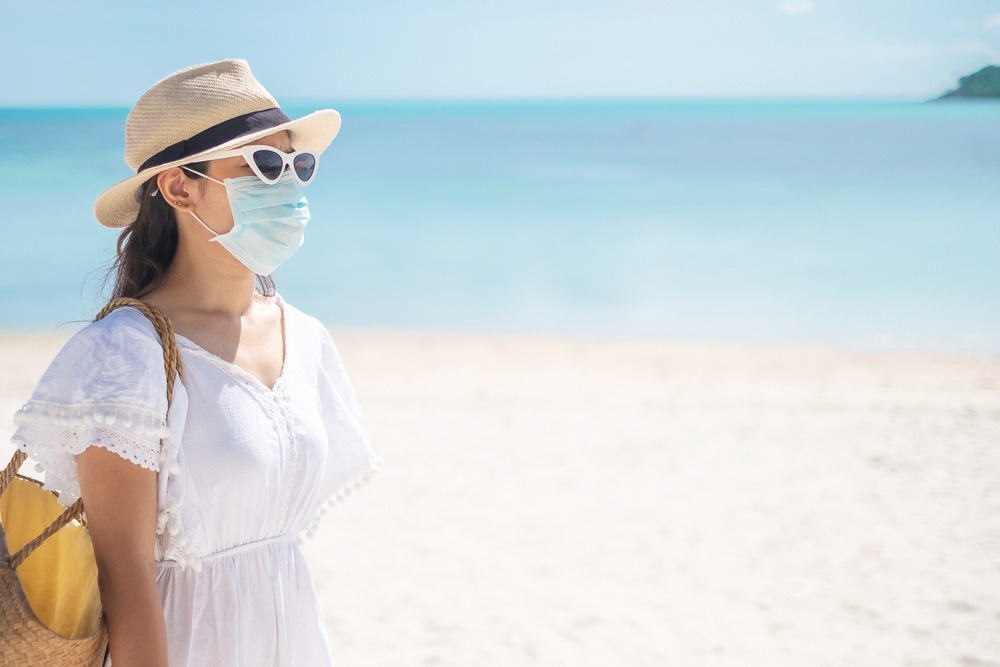Changing climate has significantly increased the need for sun protection. Titanium dioxide (TiO2) nanoparticles have a remarkable ultraviolet (UV) protection rating and are particularly resilient to UV radiation.

Study: UV protective fabric for face covering utility article using TiO2 nanoparticles. Image Credit: Jo Panuwat D/Shutterstock.com
A corrected proof study from the journal Materials Today: Proceedings focuses on employing TiO2 nanoparticles to improve the UV protection of cotton fibers. Applying TiO2 nanoparticles demands the use of both a cross-linking reagent and a catalyst, both of which have adverse outcomes. As a result, a proof of concept for TiO2 nanoparticles was also provided in this research to enhance their application procedure.
Ultraviolet (UV) Radiations: Overview and Exposure Risks
Ultraviolet light is a type of electromagnetic radiation emitted by the sun and artificial sources such as sunbeds and welding lamps. Even though UV rays make up a minor part of the sun's beams, sunlight is the primary source of UV radiation.
UV rays of various kinds reach the earth in varying quantities. The sun's UVA rays account for around 95% of the UV rays that reach the planet, with the remaining 5% being UVB rays.
UVA rays have the least amount of energy of any UV light. UVA rays are mostly associated with long-term skin conditions such as wrinkling, but they may also play a role in certain skin cancers. UVB rays have a somewhat higher intensity level than UVA rays. They are the primary rays that cause sunburns because they can directly destroy the DNA in skin cells.
In addition to skin cancer, UV radiation can cause various other health issues. Sunburn may be caused by UV rays emitted by the sun or artificial sources such as tanning beds. UV radiation may cause premature skin aging and sun damage symptoms such as wrinkling, leathery skin, dark spots, actinic keratosis, and solar elastosis.
UV Resistant Fabrics: The Future of UV Protection
Several light summertime garments are unsuitable for individuals who spend their whole day in the sun. As a result, the garment industries are presently focused on creating attractive clothes that not only offer UV protection but are also composed of non-toxic substances and have a less detrimental impact on the skin.
As the prevalence of skin cancer has grown in many regions worldwide, research into UV protective materials and fabric technologies has also intensified. Small amounts of UV radiation are beneficial to humans since they assist with bone building, vitamin intake, and other functions. Nevertheless, high levels of exposure increase the risk of irreparable skin degradation, which may contribute to accelerated skin aging.
Nowadays, people typically use sunblocks or common breathable cotton fabrics to mask their faces. However, such clothes only guard them against dust and do not offer adequate UV protection factor (UPF) values of 30+.
Highlights of the Current Study
There is an urgent need to create an appropriate fabric that can shield the face from dangerous UV ray exposure while also protecting the wearer from dust/polluted air without creating difficulties breathing.
The researchers in this study provide a remedy to this issue in the shape of UV-resistant face-covering products made from TiO2 nanoparticles.
The surface of the treated cotton fabric was evaluated using a scanning electron microscope (SEM) to validate the deposition of TiO2 nanoparticles on the cotton. Fourier transformation infrared (FTIR) spectroscopy was used to determine the chemical makeup of the raw TiO2 nanoparticles and the treated cotton fabric. The UV-protection factor (UPF) and crease recovery features of the cotton fabric treated with TiO2 nanoparticles were also evaluated.
Key Developments of the Research
The treatment with TiO2 nanoparticles substantially increased the aesthetic and operational qualities of the as-prepared UV-resistant cotton fabric. According to the SEM and FTIR data, the TiO2 nanoparticles were successfully linked to the textile fabric and could endure more than 20 washing cycles.
The percentage of the cross-linking agent (citric acid) had a substantial impact on the crease recovery characteristic of textiles treated with TiO2 nanoparticles, with a peak crease recovery angle (CRA) value of 156 recorded at a 5% concentration of citric acid.
Furthermore, the TiO2 nanoparticles acquired a maximum UPF rating of 30+. Despite a minor reduction in UV absorption, the UPF value of the cotton fabric treated with TiO2 nanoparticles was maintained even after 25 washing cycles, suggesting outstanding durability, which is one of the most important criteria for textile materials.
Reference
Madhu, A. et al. (2022). UV protective fabric for face covering utility article using TiO2 nanoparticles. Materials Today: Proceedings. Available at: https://www.sciencedirect.com/science/article/pii/S2214785322054347?via%3Dihub
Disclaimer: The views expressed here are those of the author expressed in their private capacity and do not necessarily represent the views of AZoM.com Limited T/A AZoNetwork the owner and operator of this website. This disclaimer forms part of the Terms and conditions of use of this website.